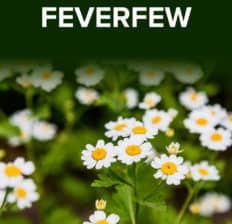


Suffer from chronic headaches and migraines? Looking for a natural remedy that has a proven track record of success in preventing and treating some of the worst headaches imaginable? You might want to try feverfew, an herb that’s well-known for being a potent natural headache remedy.
For centuries, traditional uses of this herb have included:
- fevers
- headaches
- stomachaches
- toothaches
- insect bites
- infertility
- problems with menstruation and labor during childbirth
Newer folk or traditional uses for feverfew include:
- migraine headaches
- rheumatoid arthritis
- psoriasis
- allergies
- asthma
- tinnitus
- dizziness
- nausea and vomiting
Feverfew’s pain-easing effect is said to come from a biochemical called parthenolides, which combat the widening of blood vessels that occurs in migraines. It may even be more effective than other nonsteroidal anti-inflammatories (NSAIDS), like aspirin!
With at least 39 million Americans suffering from migraines, the search for relief is on a lot of hurting minds.
Ad


What Is Feverfew?
The feverfew plant (Tanacetum parthenium) is a short bush with daisy-like flowers belonging to the Asteraceae or Compositae family that was originally native to the Balkan Mountains of Eastern Europe. It now grows throughout Europe, North America and South America.
The dried leaves (and sometimes flowers and stems) are used to make supplements, including capsules, tablets and liquid extracts. The leaves are also sometimes eaten fresh.
The chemistry of feverfew is well-defined with the most important biologically active component being sesquiterpene lactones, the principal one being parthenolide. Parthenolide is one of the main reasons it’s such an excellent anti-inflammatory. Feverfew also contains flavonoids and volatile oils.
The name feverfew stems from the Latin word febrifugia, which means “fever reducer.” The first-century Greek physician Dioscorides prescribed the herb for “all hot inflammations.” It’s also known as “featherfew” because of its feathery leaves.
The ancient Greeks also called feverfew “Parthenium,” supposedly because it was used medicinally to save the life of someone who had fallen from the Parthenon during its construction in the fifth century B.C. The first-century Greek physician Dioscorides used it as an antipyretic (something that reduces or stops a fever). It also was known as “medieval aspirin” or the “aspirin” of the 18th century.
In Central and South America, the plant has been used to treat a variety of disorders. The Kallaway Indians of the Andes Mountains value its use for treating colic, kidney pain, morning sickness and stomachache.
Costa Ricans use a decoction of feverfew to aid digestion, as a cardiotonic, an emmenagogue (herb that stimulates blood flow in the pelvic area and uterus) and as an enema for worms. In Mexico, it’s used as an antispasmodic and a tonic to regulate menstruation. In Venezuela, it’s used for treating earaches.
Related: Usnea Benefits for the Kidneys, Immunity, Respiratory System & More
Health Benefits
1. Can Relieve Migraines
Research shows that consuming feverfew helps reduces the frequency and get rid of migraine headaches and headache symptoms, including pain, nausea, vomiting, and sensitivity to light and noise.
Several impressive human studies have shown the positive effects of using feverfew to prevent and treat migraines. A survey of 270 people with migraines in Great Britain found that more than 70 percent of them felt much better after taking an average of two to three fresh leaves daily.
Another study published in Clinical Drug Investigation used a combination of feverfew and white willow bark, which has chemicals like aspirin. People who took the combination twice a day for 12 weeks had fewer migraines, and the pain did not last as long or hurt as much.
In addition, a systematic review completed by the School of Postgraduate Medicine and Health Science in the U.K. compared the results of six studies. Researchers found that feverfew is effective in the prevention of migraine headaches and doesn’t pose any major safely concerns.
2. Helps Calm Rheumatoid Arthritis
Rheumatoid arthritis is a chronic inflammatory disorder that typically affects the small joints in the hands and feet. An autoimmune disorder, rheumatoid arthritis occurs when your immune system mistakenly attacks your own body’s tissues.
Feverfew is thought to hinder the production of prostaglandins, the hormone-like substances that cause pain and inflammation.
In a 1989 study of women with symptomatic rheumatoid arthritis, feverfew was tested as a form of relief since laboratory tests previously showed that it can generally reduce inflammation. The women took dosages of 76 milligrams of dried, powdered feverfew leaf but acknowledged that 100–125 milligrams was previously suggested as an effective dosage.
Ad


The researchers ultimately admit that perhaps at larger doses it might have some benefit for rheumatoid arthritis.
While more research is needed, another 2009 study conducted by the Department of Orthopaedics at Osaka University Graduate School of Medicine also found that the parthenolide “ameliorated the severity of joint destruction in experimental animal model,” concluding it helps in a natural arthritis diet.
3. Treats Dermatitis
Dermatitis is a general term that describes an inflammation of the skin. It has many causes and occurs in many forms.
Dermatitis usually involves an itchy rash on swollen, reddened skin. Feverfew is a potent anti-inflammatory that’s particularly effective at calming redness.
Studies have shown that it may help reduce damaged skin cells and inflammation, in addition to helping relieve dermatitis and improve the appearance of the skin. In 2009, researchers showed that feverfew extracts (with parthenolide removed) had potent anti-inflammatory activity, suggesting that this botanical is effective at relieving skin inflammation without inducing immune sensitization.
READ RELATED: Exploring the Benefits and Uses of Red Raspberry Leaf Tea
If you have rosacea or regularly experience rash reactions, a topical remedy containing feverfew could likely offer relief, making it an effective rosacea treatment and rash natural remedy. It also naturally protects the skin from UV rays.
4. Potentially Combats Cancer
Research published in the Journal of Medicinal Food demonstrated the anticancer effects of feverfew extracts on two human breast cancer cell lines (Hs605T and MCF-7) and one human cervical cancer cell line (SiHa). Feverfew ethanolic extract inhibited the growth of all three types of cancer cells.
Among the tested constituents of feverfew (parthenolide, camphor, luteolin and apigenin), parthenolide showed the highest inhibitory effect. While it has yet to get widespread attention as a natural cancer fighter, the research is promising!
5. Helps Prevent Blood Clots
Typically, blood flows through our arteries and veins smoothly and efficiently, but if a clot, or thrombus, blocks the smooth flow of blood, then the result (called thrombosis) can be very serious and even cause death. Serious problems arising from clots in blood vessels include heart attack and stroke.
Research indicates that feverfew may have antithrombotic potential. As an antithrombotic agent, it can help prevent blood clots from forming and growing — and hence reduce the risk of death from heart attack or stroke!


Feverfew vs. Butterbur
Like feverfew, butterbur is another herb that has a long and well-researched history of success as a natural migraine and headache remedy. There are also several other health ailments they’ve both been known to treat successfully.
It’s actually not uncommon to find a supplement that combines the two herbs for headache relief.
Butterbur has historically been used for a variety of health issues, including:
- pain
- headache
- anxiety
- cough
- fever
- gastrointestinal issues
- urinary tract conditions
- topically to improve wound healing
Today, traditional or folk uses of butterbur include:
- nasal allergies
- allergic skin reactions
- asthma
- migraine headache
For centuries, traditional uses of feverfew include:
- fevers
- headaches
- stomachaches
- toothaches
- insect bites
- infertility
- problems with menstruation and with labor during childbirth
Newer folk or traditional uses include:
- migraine headaches
- rheumatoid arthritis
- psoriasis
- allergies
- asthma
- tinnitus
- dizziness
- nausea and vomiting
They’ve both historically been used for:
- headaches
- pain
- fever
- gastrointestinal issues
- migraines and headaches
- skin issues
- asthma
- allergies
Dosage
Feverfew supplements come in the form of capsules, tablets or liquid extracts. The feverfew contained in each supplement is either fresh, freeze-dried or dried.
Supplements used in clinical studies contain a standardized dose of parthenolide. They should be standardized to contain at least 0.2 percent parthenolide.
To prevent or stop an adult migraine headache, take 100–300 milligrams of feverfew up to four times daily, standardized to contain 0.2 percent to 0.4 percent parthenolides. In children over 2 years of age, adjust the recommended adult dose to account for the child’s weight.
Most herbal dosages for adults are calculated on the basis of an average of 150-pound adult. Therefore, if the child weighs 50 pounds, the appropriate dose for this child would be a third of the adult dosage.
The freeze-dried capsules are generally recommended because the fresh leaves have a bitter taste and may irritate your mouth. The leaves can be made into a tea, but again this can taste bitter and may irritate your mouth.
Side Effects and Drug Interactions
Feverfew should never be given to children under 2 years old. For older children, ask your doctor whether it’s safe for your child. If so, your doctor will determine the right dose.
Women who are pregnant should not use it because it may cause the uterus to contract, increasing the risk of miscarriage or premature delivery. Women who are nursing should also avoid its use.
It’s possible to have an allergic reaction to feverfew. If you’re allergic to other members of the daisy family (including ragweed and chrysanthemums) then you are more likely to be allergic to it.
No serious side effects have been reported, but less common side effects from feverfew include abdominal pain, indigestion, gas, diarrhea, nausea, vomiting and nervousness. Some people who chew the raw leaves may have mouth sores, loss of taste, and swelling of the lips, tongue and mouth.
Don’t take feverfew together with aspirin, ginkgo biloba or other blood-thinning agents. Talk to your doctor before taking it if you have any chronic health issues or you take blood-thinning medication or medications that are broken down by the liver.
If you’re scheduled for surgery, tell your doctor since it may interact with anesthesia.
If you have taken feverfew for more than one week, do not abruptly stop taking it. Stopping it too quickly may cause rebound headaches, anxiety, fatigue, muscle stiffness and/or joint pain.
Final Thoughts
Feverfew is a well-respected herb in both the traditional and modern medicine worlds. For migraines and headaches, it’s without a doubt one of our top recommendations for natural relief, but it doesn’t stop at migraines.
We can’t forget that it also does the following:
- Helps calm rheumatoid arthritis, treat dermatitis, potentially combat cancer and prevent blood clots.
- It’s also been used to treat fever, stomachaches, toothaches, insect bites, infertility, problems with menstruation and labor during childbirth, psoriasis, allergies, asthma, tinnitus, dizziness, nausea, and vomiting.
- It comes in capsule, tablet or liquid extract form as a supplement, and its leaves can be eaten raw.
- Parthenolides in feverfew are thought to provide the biggest anti-inflammatory benefits.
!function(f,b,e,v,n,t,s)
{if(f.fbq)return;n=f.fbq=function(){n.callMethod?
n.callMethod.apply(n,arguments):n.queue.push(arguments)};
if(!f._fbq)f._fbq=n;n.push=n;n.loaded=!0;n.version=’2.0′;
n.queue=[];t=b.createElement(e);t.async=!0;
t.src=v;s=b.getElementsByTagName(e)[0];
s.parentNode.insertBefore(t,s)}(window, document,’script’,
‘
fbq(‘init’, ‘3475171552810057’);
fbq(‘track’, ‘PageView’);





